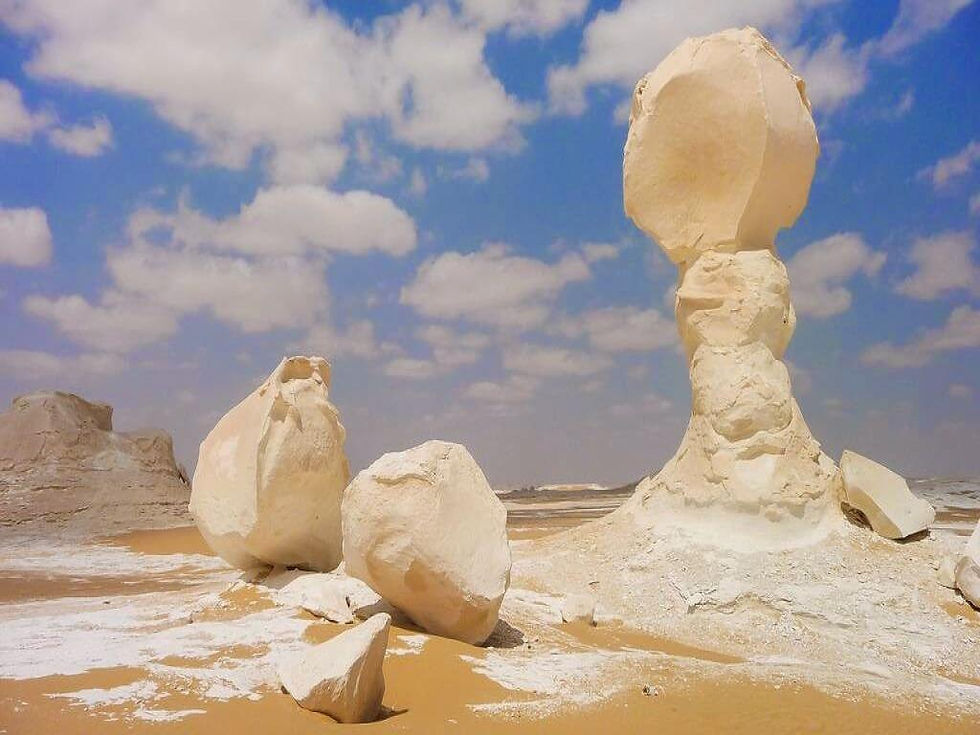Discover Bahariya oasis
- mahamim2517
- Nov 12, 2019
- 3 min read
Updated: Jan 18, 2020
Bahariya is one of the more fetching of the desert circuit oases, and at just 365km from Cairo, it's also the most accessible. Much of the oasis floor here is covered by sprawling shady date palms and speckled with dozens of natural springs, which beg to be plunged into. The surrounding landscape of rocky, sandy mesas is a grand introduction to the Western Desert's barren beauty.
The oasis is the smallest of the four oasis depressions, only 94km long and 42km wide. In the Late Cretaceous era, 94 million years ago, this was a steamy mangrove-swamp inhabited by dinosaurs such as the plant-eating paralititan and the carnivorous carcharodontosaurus (whose bones have been found here).
Bahariyya itself is not that impressive.
The main town of Bawiti is full of squat buildings of modern construction and there is a conspicuous absence of the lush greenery you might expect of an oasis. Further from the town center the construction turns to more traditional mud-brick and the palm groves become more evident. Historically, Bahariyya was different.
History of Bahariya oasis

The oasis has a rich history, going back at least to Egypt’s Middle Kingdom (2000-1800 BCE), when agricultural products from the oasis were exported to the Nile Valley. Alexander the Great may have passed through this oasis, even though it is so remote (380 kilometers southwest of Cairo). The Valley of the Golden Mummies in Bahariya purportedly holds as many as 10,000 undisturbed mummies of Roman and Greek aristocrats, dating from 332 B.C.E. to 395 A.D. Aqueducts built by the Roman Empire are still used today to carry water to groves and farms.
During the Roman Period it was one of the greenest places in Egypt, producing large amounts of wheat and wine that were shipped to the Nile Valley. It is thought that the population swelled to nearly half a million people during this time. A recent archaeological find revealed a vast, wealthy necropolis with nearly 10,000 mummies from this era.
Bahariya oasis now

El Bahariya has four major towns; Bawiti that is considered to be the capital of the oasis and the most important town and El Qasr, the most ancient section of the Bahariya Oasis. This is beside the two other smaller villages of Mandisha and Zabw.
The area around Bawiti has some ancient necropolises of sacred animals like that of the hill of the chicken Merchant or Farargi, that hosts some burial chamber of ibis.
There is the also the Hilwa Mountain or the charming Mountain that hosts the most ancient historical tomb in Bahariya that dates back to the reign of the 18th dynasty that ruled Egypt in the 13th century BC. This tomb belongs to Amenhotep-Hay, the governor of the oasis at the time.
The Bahariya Oasis also has some wonderful natural springs that have wonderful curative effects like the Ain Bishmu, which was used as early as the Roman period in Egypt.
Among the most important historical sites in the Bahariya Oasis is the Valley of the Golden Mummies. This was where an ancient necropolis dating back to the Roman period was discovered to the Southwest of Bawiti.

The archaeological mission that began in 1999 found that this area hosts the most important and largest Roman necropolis in Egypt. The studies showed that this area has thousands of tombs all over the surface area that is more than 35 square kilometers.
The discoveries so far have unearthed more than 250 mummies that are featured with their wonderful golden covers and wonderful inscriptions. Some of these mummies are now put on display in the Museum of the Golden Mummies in El Bahariya Oasis.
Another interesting historical site in El Bahariya Oasis is the necropolis of Ain El Meftella. This historical site is located four kilometers west of the town of El Qasr. It consists of four chapels that were discovered in 1939 by Ahmed Fakhri, one of the most important Egyptian archaeologists who had many discoveries and studies in the Western Desert of Egypt.
All the chapels at Ain El Meftella date back to the ruling period of the 26th dynasty in the 5th century BC and they have some wonderful fine preserved wall paintings and inscriptions.
The climate of El Bahariya Oasis plays a very important role in the international fame the oasis gained for its curative purposes. This is beside the fact that the oasis has many hot and cold Sulfur natural springs. The Egyptian government has also established many resorts and hotels in the area to encourage tourists to visit Egypt and enjoy their time in the Bahariya Oasis.

Maybe the most significant tour the attracts tourists to this area is the white desert tour. This tour will take you into the surrounding desert to see the unique regions known as the Black and White Deserts in a unique adventure experience.







Comments